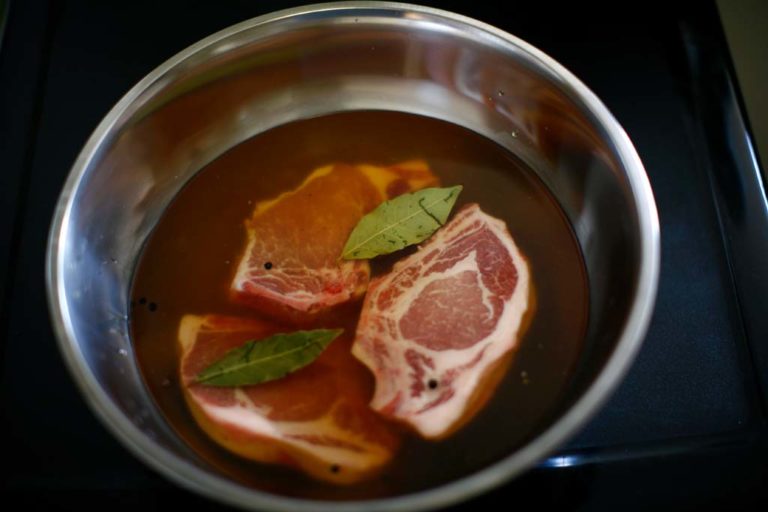
Chef's notes:
Brine is little more than sugar and salt dissolved in water. To brine meat you submerge the meat in the solution and let it sit for 30 minutes to 30 hours depending on the size and intensity of flavor you desire. The reason this works is because meat is composed of cells, and cells have these things called membranes. Membranes desire nothing more than balance. So, if they detect more salt on one side of the membrane than the other, they move some salt across the membrane in a process called diffusion. Diffusion of a liquid across a membrane is called osmosis. Osmosis is the key to brining.
The brine is pumped into the meat, resulting in more liquid and more flavor. At the same time the salt denatures proteins present in the meat. These denatured proteins are suddenly very effective at hanging on to water, which means that brined meats are juicier when cooked and they are more forgiving to accidental overcooking.
Ingredients
- 4 rib loin pork chops
- 2 C chicken stock
- ¼ C kosher salt
- ¼ C brown cane sugar
- ½ tsp black peppercorns
- 2 bay leaves
- ½ Tbsp apple cider vinegar
- 2 C ice water
Bone-in Rib Loin Chops Brined in Chicken Stock, Salt, Pepper, and a Little Apple Cider Vinegar
- The base of brine is sugar, salt, and water, but you can add any flavor to it that you want. My basic starter brine is as follows: 2 C stock (vegetable or chicken), ¼ C salt, ¼ C brown cane sugar, ½ tsp black peppercorns, 2 bay leaves, ½ Tbsp apple cider vinegar, and 2 C ice water. Combine everything except the ice water in a saucepan and heat on low just until the sugar and salt dissolve, stirring with the whisk.
- Once the sugar and salt are dissolved, remove the saucepan from the heat to a hot pad. Stir in the ice water to cool the brine to under 90 degrees F. Use a thermometer to make sure the brine is cool. You don’t want to put your meat into hot brine, as it will cook the meat a little. You also want to cool the brine for safety reasons. The chance of food-borne illness is pretty low in a mixture this salty, but it pays to be extra careful. You can taste the brine if you want, but it will be really salty.
- You need a reliable storage device for the pork chops as they brine in the fridge. Normally I would use a large zipping storage bag inside of a bowl, but I ran out, so I had to use a metal bowl covered with aluminum foil. This method will work; there is just more of a chance for cross-contamination because it is not an airtight seal. Just make sure to cover the bowl with something. I used aluminum foil, but plastic wrap would be better. But I was also out of that, too. Time to go shopping, I think.
- How long you brine your pork chops is entirely up to you. The longer they sit in the brine the stronger the flavor will become. But remember these chops are already chopped up, and unlike a whole roast, it will not take 24 hours for the flavors to penetrate the center. There will be noticeable flavor change after just 30 minutes of soaking. I would not leave them for longer than 8 hours. After 8 hours the flavors are almost peaked out. Take the meat out of the brine and pat it dry with paper towels.
Tips & Tricks
- Large chunks of meat, like roasts or whole birds, will take much longer than small cuts of meat, like chops and steaks, to brine. So start the brining process the day before for the large chunks. If the meat and brine mixture won’t fit in your refrigerator, use a cooler filled with ice. Clean out the cooler before putting meat in it. Use a lot more ice and less liquid for the recipe, without reducing the concentration of spices and salt too much. Cover the meat with ice and pour the brine over it. Keep a thermometer in the cooler to make sure the temperature stays under 40 degrees F.
- The process is pretty standard, but you can adapt it to suit your needs and or palate. There are a lot of options for flavor introduction using the brining process. Just keep the basic recipe the same but replace sources of sugar and liquid as you wish. Sugar substitutes like honey, molasses, fruit juices, and sugared soda are popular. If you use a salty stock, you won’t need to add as much salt. The process of brining is pretty fool-proof, and it makes cooking a lot easier, too.
